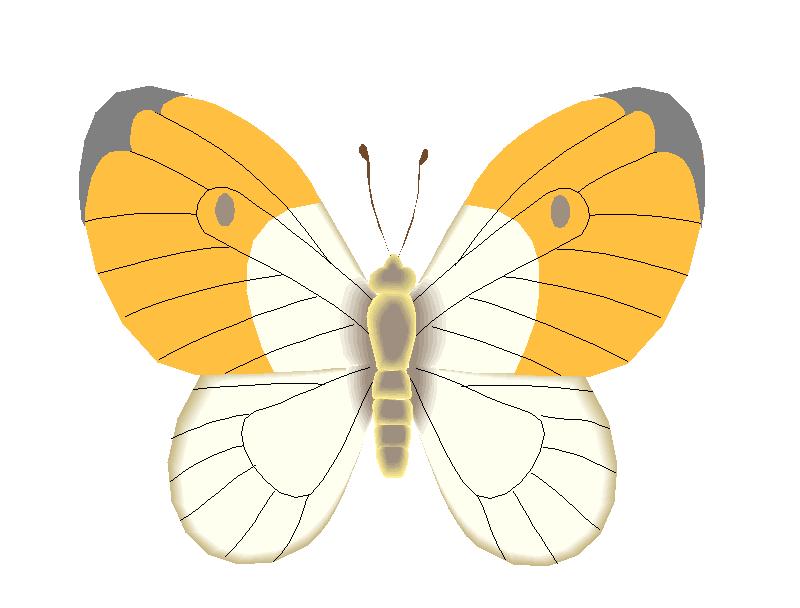 Butterfly Gardening - March 17, 2004 Jeff Schalau, County Director, Agent, Agriculture & Natural Resources Arizona Cooperative Extension, Yavapai County Over 350 butterfly species have been found in Arizona. Our ecosystem diversity, large land area, and proximity to the subtropics certainly contribute to this fantastic array. Dedicated gardeners can create butterfly habitats that attract multiple species of butterflies to your landscape. There are many books and web sites that can help you create butterfly gardens and identify the butterflies that visit your garden. This column will hopefully pique your interest and give you some basic information to get you started with butterfly gardening. As most people know, butterflies go through a four-stage developmental process known as metamorphosis (egg, larva or caterpillar, pupa or chrysalis, and adult). Understanding a butterfly's life cycle can make observing them more enjoyable and give you a greater appreciation of butterfly gardening. Depending on the species, the life cycle of a butterfly (one generation) may take anywhere from about one month to an entire year. Usually, the most common butterflies are multiple-brooded and provide a continuous array of color and activity to your butterfly garden throughout the season. Although plant selection and placement are the most effective methods to attract butterflies, site selection for a butterfly garden is also important. Butterflies like sunny sites and areas sheltered from high winds. Warm, sheltered sites are most needed in the spring and fall. Provide rocks or bricks for pupation sites and for basking and warming in the sun. Butterflies require food plants for their larval stages and nectar plants for the adult stage. Some larvae feed on specific host plants, while others will feed on a variety of plants. If possible, include both larval host plants and adult nectar plants in your butterfly garden. A few woody plants in the butterfly garden will provide protection from predators, offer shelter, a place to lay eggs, and a place to attach chrysalides. It can be relatively simple to attract butterflies and still have a garden that suits your tastes and needs. Nectar flowers and other favorite butterfly plants come in many forms--annuals, perennials, herbs, vines, grasses, shrubs, and trees. Plants with clusters of flowers are often better than plants with small, single flowers because it is easier for butterflies to land on clustered and/or larger flowers. Planting in mass (several plants of the same kind) will usually attract more butterflies, as there is more nectar available to them at a single stop. Select plants adapted to your site and location, and develop a plan for the butterfly garden. In addition, pesticides should not be used in or near butterfly gardens. This includes Bacillus thuringiensis (Bt) which is a toxin to caterpillars. Wet soil or areas around ponds are frequently visited by male butterflies ó a behavior called "puddling" which they extract sodium and other nutrients needed for mating. Butterflies seem especially attracted to a soaker hose laid on top of the vegetable garden. Some plants that provide food for butterfly larvae include: cabbage, common sunflower, lambís quarter, snapdragon, hollyhock, Queen Anneís lace, dill, parsley, fennel, alfalfa, aster, clover, mallow, milkweed, and grasses. Some common nectar producing plants include: cosmos, zinnia, nasturtium, marigold, petunia, sweet alyssum, catnip, mint, chives, blanket flower, chrysanthemum, phlox, pinks, and yarrow. I hope this column inspires some readers to start butterfly gardening. For a comprehensive list of Arizona butterflies (with photos), visit the following USGS web site: www.npwrc.usgs.gov/resource/distr/lepid/bflyusa/az/toc.htm#metalmarks. For more information about butterfly gardening, visit the following Maricopa County Cooperative Extension web site: ag.arizona.edu/maricopa/garden/html/youth/btrfly.htm. The University of Arizona Cooperative Extension has publications and information on gardening and pest control. If you have other gardening questions, call the Master Gardener line in the Cottonwood office at 646-9113 ext. 14 or E-mail us at mgardener@verdeonline.com and be sure to include your address and phone number. Find past Backyard Gardener columns or submit column ideas at the Backyard Gardener web site: http://cals.arizona.edu/yavapai/anr/hort/byg/. |